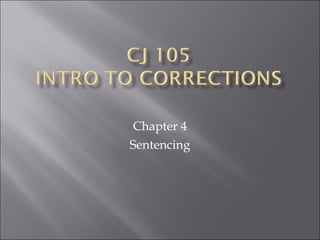
Ch 4
Hinweis der Redaktion
- Sentence is a court imposed penalty or sanction against a person who has been convicted of a crime. No sentence can be given out until a conviction has occurred. This is different from a judge ordering someone to be held in jail until a trial date. That is not a sentence.
- Who makes sentencing policies? What do you think drive sentencing policies? The legislature makes sentencing policies and they are politicians who are elected. Therefore they react to public opinion. If a certain type of crime is becoming highly publicized and the public outcry is big you will see changes to the sentencing policies in a knee jerk reaction. Sentencing policies are very complex because of this reason. Sentences can include fines, community service, probation or incarceration. Because of all these factors there is no typical punishment.
- Determinate sentencing is a system where specific and fixed penalties were imposed. This is where the offender is sentenced to a very specific term for example 10 years in prison. Indeterminate sentencing came about when reformers felt that fixed sentences did nothing to motivate inmates to reform. The power to release inmates was given to wardens and parole boards. An example of this sentencing is no less than 5 years and no more than 15. So the inmate would be eligible for parole after five years and every year after. Dissatisfaction with indeterminate sentencing has led to a call for a return to determinate style of sentencing to what is called truth in sentencing.
- Indeterminate sentencing is linked more to rehabilitation and behavior change than to punishment. Inmates know that the better they behave and change the earlier they can be released through parole. In the 1980’s the maximum was many times left open by the judge. There was disparity whereby one burglar was being released in one year and another in three. This has led to state legislators creating statutory penalties whereby sentences are linked directly to specific crimes or type of crime such as misdemeanors and felonies. They have also passed legislation that sets a statutory maximum-the most amount of time a judge an impose.
- In the 1970’s criticism began to mount on the form of indeterminate sentencing. Proponents claimed that sentences should be base don the individual crime, and offender many argued that this theory overlooked poverty and education levels and that discrimination was rampant. The other issue is that behavioral science has not yet evolved to the point where parole boards can actually tell if an inmate has changed their life or knows what to say. Parole boards also had the power to release some inmates early and hold others longer for the same crimes. This disparity led many states to alter or abandon indeterminate sentences.
- Political debate was heavy over the use of indeterminate sentencing. The political right were upset because parole boards were releasing inmates too early. The left was upset because many inmates were being held too long. They both agreed indeterminate sentencing was bad but for different reasons. Determinate sentencing is seen as truth in sentencing.
- Sentencing practices: Both indeterminate and determinate sentencing are tied to a just deserts philosophy where the inmate gets what they deserve and a collective incapacitation (chapter 2) because they require similar sentences for comparable crimes. A third strategy is the consideration of aggravating and mitigating circumstances. Aggravating: circumstances of crime make it more severe Mitigating: circumstances may make going easy on offender more likely
- Sentencing guidelines impose a predefined sentence length based on the severity of the crime and the criminal history of the offender. The judge can depart (impose greater/lesser sentence) when circumstances warrant. Voluntary-suggest possible sentences to judges but they are not required to use them. Presumptive-judges required to impose sentence within the range established and have to provide written justification for deviating from the ranges.
- Sentencing commissions are groups of people who determine suitable sentences in advance for particular crimes and offenders. State commissions are appointed and include lawyers, judges, corrections folks, legislators and citizens. Most do not have social scientist or statistician to remind group of implications of their decisions.
- All judges get a presentence report that is compiled by the probation department of their court. This information includes offenders age, education, economic, employment, past criminal history, etc. Aggravating circumstances can influence a judge to impose a tougher sentence than what is recommended by the guidelines for that offense. They can include 1. greater suffering by the victim than others in the same crime, 2. vulnerable populations –children, elderly, disabled 3. The offender is the leader of an criminal group 4. The offender continues to engage in crime after their arrest Mitigating circumstances-advocate a lighter sentence: 1. offender’s youthfulness 2.No past record 3. developmental disability or mental impairment 4. minor role as accomplice
- Under the federal sentencing guidelines judges cannot consider age, home environment, mental abnormalities, education, employment, drug/alcohol use, community ties. There was a perceived high rate of departures from the guidelines and the 2003 Feeney Amendment was passed. In actuality there had been a 36 % departure in federal cases. 35.4% were downward departure and .06 was upward Most downward were because prosecutors had recommended lighter sentences for offenders cooperation in ongoing investigations. “substantial assistance is statutorily recognized as legitimate reason for going below minimum.
- Mandatory sentencing: prison sentence mandatory for some crimes and some offenders. -collective incapacitation -just desserts Examples are 3 rd strike laws, weapons used in a crime and in 31 states DUI.